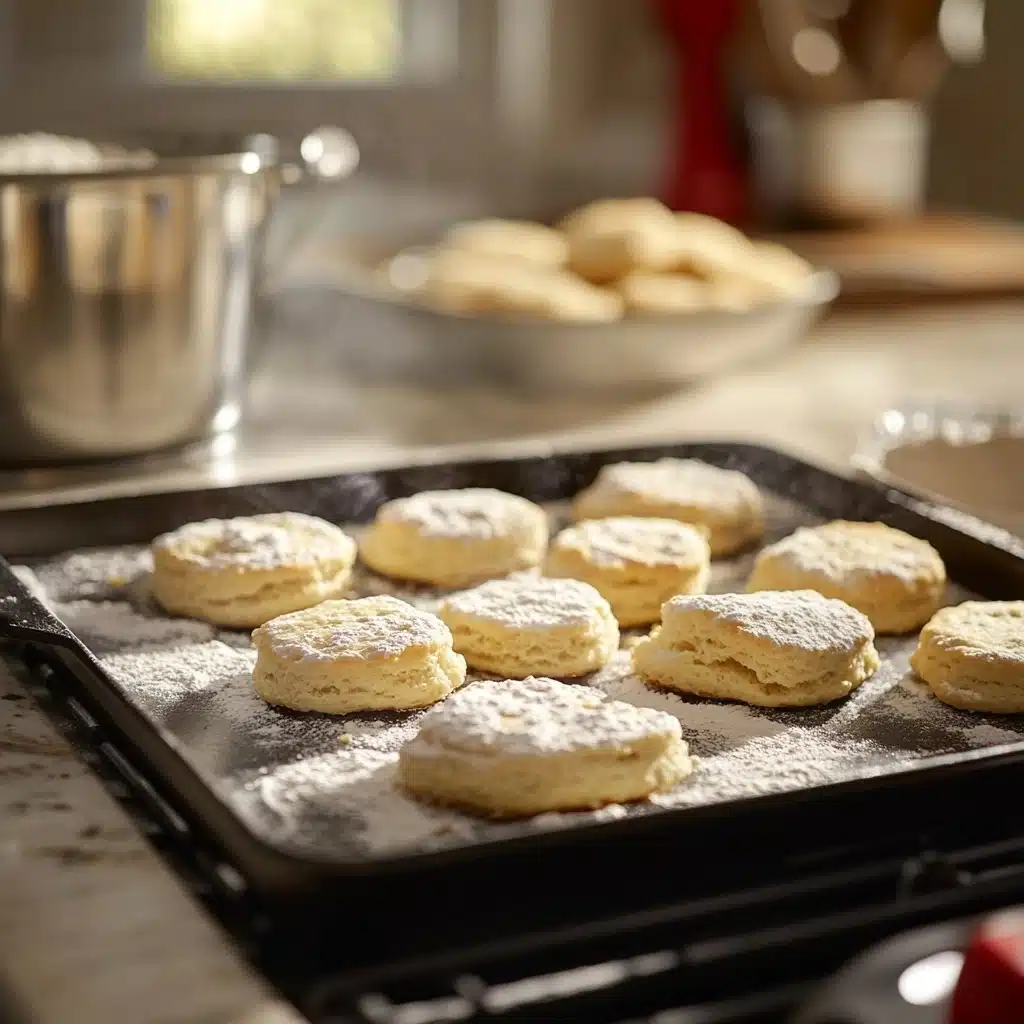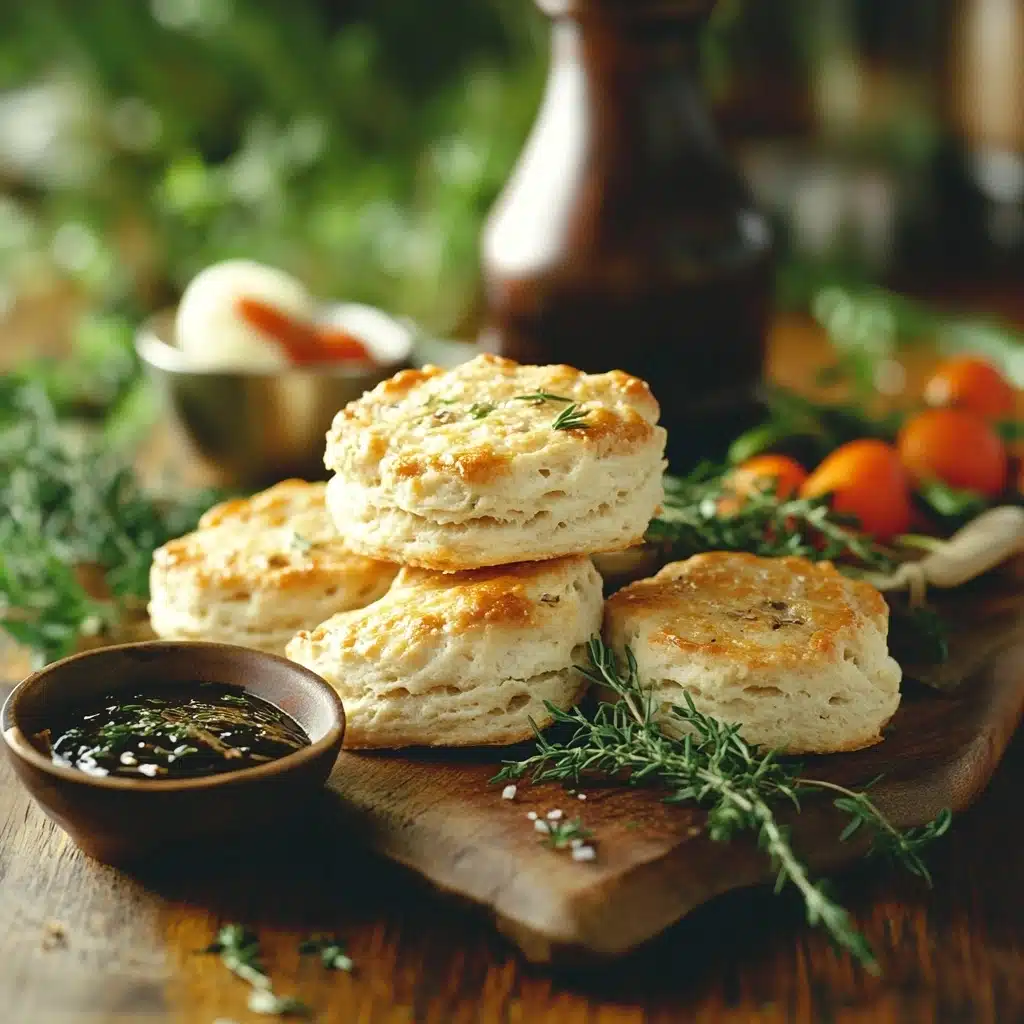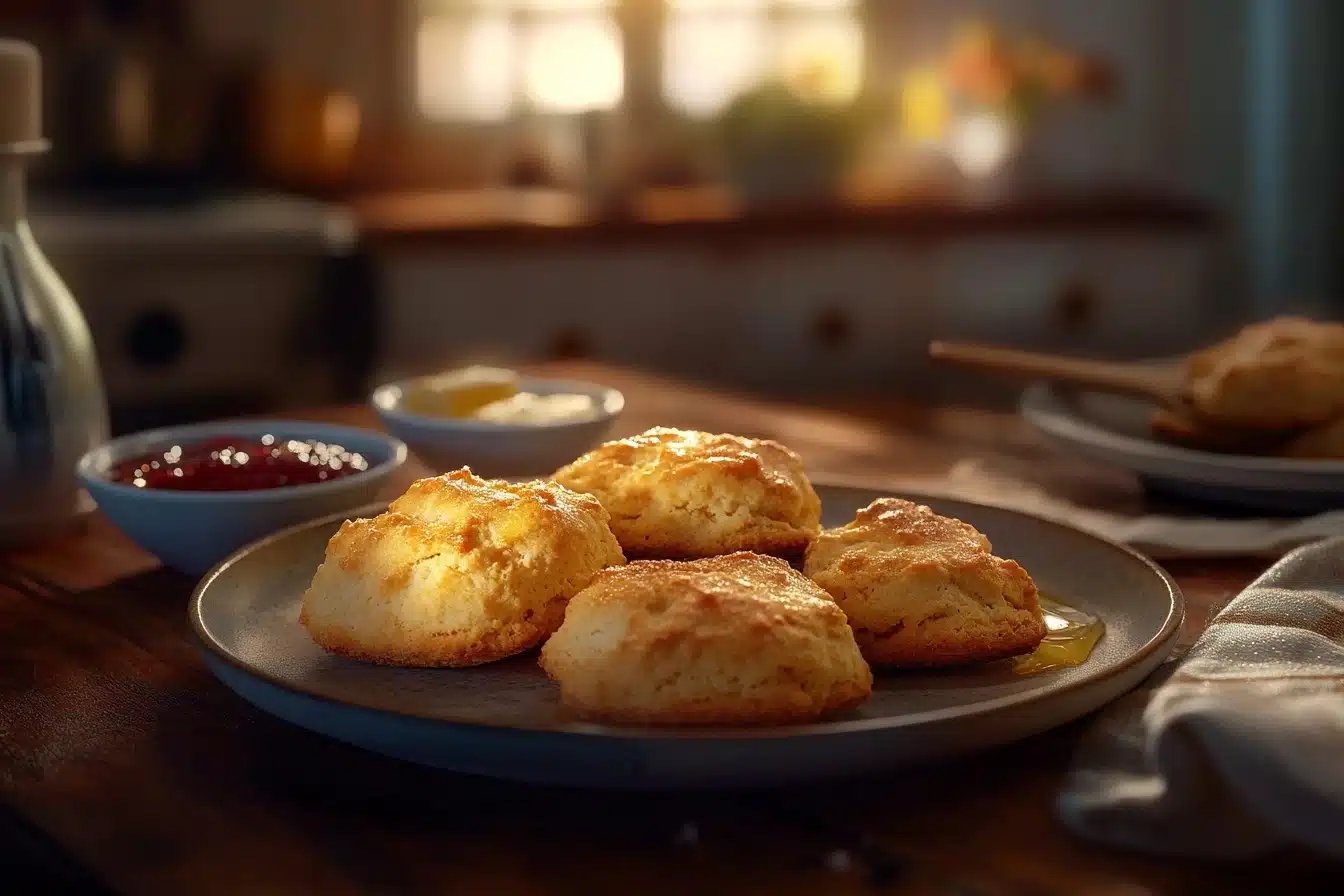Bisquick biscuits are a staple in kitchens for a good reason—they’re quick, easy, and incredibly versatile. From classic recipes to creative twists, there’s so much to love about these light and fluffy treats. In this guide, we’ll cover everything from their fascinating history to tips for achieving the perfect texture. Whether you’re a seasoned baker or a curious newbie, this article has something for you. Let’s dive right into the wonderful world of Bisquick biscuits!
Introduction to Bisquick Biscuits
What Are Bisquick Biscuits?
Bisquick biscuits are a timeless quick bread made using Bisquick, a versatile baking mix that simplifies kitchen tasks. This all-in-one mix, a pantry favorite, contains pre-measured flour, shortening, and leavening agents. By simply adding milk or water, you can whip up a dough in minutes—no sifting, measuring, or guessing required.
The magic of Bisquick biscuits lies in their consistency. They’re light, fluffy, and adaptable, fitting seamlessly into breakfasts, snacks, and dinners. Whether you’re topping them with butter, slathering them with jam, or dipping them into soups, these biscuits always satisfy.
The Popularity of Bisquick Biscuits
It’s not hard to see why Bisquick biscuits remain a household favorite. They bring convenience and flavor together in every bite. From a busy mom needing a quick side dish to a beginner baker gaining confidence, Bisquick biscuits fit the bill.
These biscuits also shine during holidays and gatherings. Picture them as a cozy addition to Thanksgiving dinner or a warm breakfast on a snowy morning. And don’t forget, their mild flavor opens the door for sweet and savory pairings alike. With such versatility, it’s no wonder they’ve been a go-to for generations.
The History of Bisquick Biscuits: A Timeless Favorite
Origins of Bisquick
Bisquick, the foundation of Bisquick biscuits, was born out of a moment of culinary innovation in the 1930s. The story goes that Carl Smith, a General Mills executive, tasted fresh, fluffy biscuits on a train dining car. Intrigued, he asked the chef how such delicious biscuits could be made so quickly. The chef revealed his secret: a pre-mixed combination of dry ingredients stored in an icebox.
Inspired, Smith brought the concept back to General Mills, where the idea was refined and packaged into the iconic yellow box we know today. Launched in 1931, Bisquick became a household name, offering busy families a convenient way to prepare biscuits, pancakes, and more without starting from scratch.
This revolutionary product was marketed not just as a mix, but as a modern solution for home cooks. By eliminating the need to measure and sift ingredients, Bisquick made baking faster and more accessible, giving rise to the golden era of convenience foods.
Evolution of Bisquick Biscuits Over the Years
Since its introduction, Bisquick biscuits have adapted to suit changing tastes, lifestyles, and dietary preferences. In the early days, classic biscuit recipes were promoted through cookbooks and advertisements, encouraging creativity in the kitchen. As American households embraced the mix, Bisquick biscuits evolved from a simple side dish to a versatile component of meals.
The post-war era saw the rise of “drop biscuits,” a quicker version requiring no rolling or cutting. Families loved the ease of scooping dough directly onto baking sheets, making hot biscuits more accessible than ever. In the 1970s, gluten-free and whole-grain variations began to appear, reflecting the growing interest in health-conscious baking.
Today, Bisquick biscuits remain a favorite, but their role has expanded. From adding unique ingredients like cheddar and jalapeños to using them as the base for desserts like shortcakes, home cooks continue to reinvent these iconic treats. The enduring appeal of Bisquick biscuits proves they’re more than just a mix—they’re a culinary tradition, passed down and reimagined with every generation.
How to Make Classic Bisquick Biscuits
Ingredients Needed
Making classic Bisquick biscuits requires just a handful of pantry staples, making it one of the easiest and most accessible recipes out there. Here’s what you’ll need:
- Bisquick mix: The star of the show, this pre-made mix provides all the dry ingredients you need.
- Milk: Adds moisture and helps create that soft, fluffy texture. You can also use non-dairy milk alternatives like almond or oat milk if preferred.
- Optional ingredients: Butter or shortening can be added for richer biscuits, and a pinch of sugar can sweeten them up for certain recipes.
That’s it! The simplicity of the ingredients is one of the reasons Bisquick biscuits are such a go-to option for home cooks.
Step-by-Step Preparation Guide
Making Bisquick biscuits is straightforward, even if you’re new to baking. Follow these steps for consistently delicious results:
- Preheat the oven: Begin by setting your oven to 450°F (230°C). A hot oven is key to achieving fluffy biscuits with a golden crust.
- Measure the mix: In a medium bowl, measure out 2 cups of Bisquick mix. Use a spoon to lightly scoop the mix into the measuring cup and level it off with a knife for accuracy.
- Add the milk: Pour in 2/3 cup of milk. Gently stir with a fork until a soft dough forms. Be careful not to overmix—this can lead to tough biscuits.
- Prepare your surface: Lightly flour a clean countertop or pastry board. Place the dough onto the surface and knead it gently 8-10 times. The dough should come together smoothly without being sticky.
- Roll and cut the biscuits: Roll out the dough to about 1/2-inch thickness. Use a biscuit cutter or the rim of a glass to cut out circles. Press straight down without twisting to ensure evenly risen biscuits.
- Arrange and bake: Place the biscuits on an ungreased baking sheet, spacing them about 1 inch apart. For softer sides, place the biscuits closer together. Bake for 8-10 minutes, or until the tops are golden brown.
- Serve warm: Remove the biscuits from the oven and transfer them to a wire rack. Serve warm with butter, jam, honey, or your favorite toppings.
These simple steps deliver biscuits that are light, tender, and perfect every time. And don’t be afraid to double the recipe for larger gatherings—leftovers reheat beautifully for later enjoyment!

Tips for Achieving the Perfect Bisquick Biscuit Texture
Importance of Proper Mixing Techniques
When it comes to Bisquick biscuits, mixing is a crucial step that often gets overlooked. Achieving the ideal texture relies heavily on how you handle the dough. Overmixing can lead to dense, tough biscuits, while undermixing may result in uneven pockets and crumbly bites.
Here are a few golden rules for mixing:
- Start gently: Use a fork or a pastry cutter to combine the Bisquick mix and milk. Stir just until the dough comes together; it’s okay if it looks slightly shaggy.
- Avoid overworking the dough: Kneading is essential, but keep it minimal—8 to 10 gentle turns are plenty. Kneading develops gluten, but too much will make the biscuits chewy instead of tender.
- Don’t rush: Take your time and ensure the mix is evenly moistened before rolling it out. This prevents dry spots in the final product.
By mastering these mixing techniques, you’ll create biscuits with a light, fluffy texture that melts in your mouth.
Role of Ingredient Temperature
Temperature plays a surprisingly big role in the success of your Bisquick biscuits. Cold ingredients, especially the liquid, help achieve the signature flaky texture. Why? The cold liquid slows the activation of the leavening agents in the mix, allowing the biscuits to rise evenly in the oven.
- Use cold milk or water: Keep your milk chilled until just before mixing it into the dry ingredients. This ensures the dough doesn’t get too soft or sticky.
- Avoid letting the dough sit out: After mixing, work quickly to roll, cut, and bake the biscuits. If the dough sits too long, the leavening agents may lose their effectiveness.
- Keep the kitchen cool: On warm days, consider chilling your bowl or tools briefly before starting. It’s a small step, but it makes a noticeable difference.
Attention to these temperature details ensures that every batch of biscuits is tall, fluffy, and packed with tender layers—just the way they should be.
Common Mistakes to Avoid When Making Bisquick Biscuits
Overmixing the Dough
One of the most common pitfalls when making Bisquick biscuits is overmixing the dough. While it’s tempting to stir until the mixture looks completely uniform, doing so can work against you. Overmixing activates the gluten in the flour, which is great for bread but disastrous for biscuits. The result? Dense, chewy biscuits that lack the soft, fluffy texture everyone loves.
How to avoid this mistake:
- Stir just until the ingredients combine, even if the dough looks a little lumpy or uneven.
- If kneading the dough, limit yourself to 8-10 gentle folds. Any more can toughen the biscuits.
- Remember, it’s okay if the dough feels a little sticky—this is a good sign that the biscuits will be tender and airy.
A light hand is key to getting biscuits that rise high and practically melt in your mouth.
Incorrect Oven Temperature
Another major misstep that can sabotage your Bisquick biscuits is baking at the wrong temperature. Too low, and your biscuits won’t rise properly; too high, and they may burn on the outside while staying raw in the middle. Both scenarios lead to disappointing results.
Tips for baking at the right temperature:
- Always preheat your oven to 450°F (230°C) before placing the biscuits inside. A fully preheated oven ensures the dough gets an instant burst of heat, crucial for a good rise.
- Use an oven thermometer to double-check the temperature. Even modern ovens can run slightly hotter or cooler than their settings indicate.
- Avoid opening the oven door frequently while baking. Sudden drops in temperature can cause biscuits to fall flat.
By keeping a close eye on your oven and its temperature, you’ll ensure your biscuits come out golden brown, evenly baked, and perfectly fluffy every time.
Creative Add-Ins and Toppings for Bisquick Biscuits
Savory Options: Cheese, Herbs, and Spices
Bisquick biscuits serve as a blank canvas for countless savory add-ins that can take your biscuits from simple to sensational. Adding ingredients like cheese, herbs, and spices enhances the flavor profile while keeping the preparation just as quick and easy.
Here are some savory ideas to try:
- Cheese: Shredded cheddar, parmesan, or gouda melts beautifully into the biscuits, creating a rich and gooey texture.
- Herbs: Fresh or dried options like rosemary, thyme, chives, or parsley can add an earthy kick.
- Spices: Garlic powder, paprika, or cracked black pepper gives the biscuits a bold and exciting twist.
For a foolproof option, mix shredded cheddar cheese with a dash of garlic powder and parsley for your own take on cheesy garlic biscuits. These savory variations pair beautifully with soups, stews, or even a hearty breakfast spread.
Sweet Options: Fruits, Nuts, and Glazes
If you prefer your Bisquick biscuits on the sweeter side, you’re in for a treat. Adding fruits, nuts, or a drizzle of glaze can turn these biscuits into a dessert-worthy delight—or a sweet snack perfect for any time of day.
Some sweet ideas to inspire you:
- Fruits: Fresh or dried fruits like blueberries, cranberries, or diced apples add bursts of sweetness and a pop of color.
- Nuts: Chopped pecans, almonds, or walnuts bring crunch and a nutty depth of flavor.
- Glazes: A simple drizzle of honey, maple syrup, or powdered sugar icing elevates the biscuit into a decadent treat.
For a seasonal twist, try folding in dried cranberries and orange zest, then topping the biscuits with a light orange glaze. Sweet biscuits like these are perfect for holiday gatherings, brunches, or an afternoon pick-me-up.
Both savory and sweet variations make Bisquick biscuits even more versatile, allowing you to tailor them to any meal or occasion.

Healthier Variations: How to Make Low-Fat or Gluten-Free Bisquick Biscuits
Substituting Ingredients for Lower Fat Content
Making Bisquick biscuits healthier without sacrificing flavor is easier than you might think. By swapping out some traditional ingredients, you can create a low-fat version that’s just as fluffy and delicious.
Here are some smart substitutions:
| Traditional Ingredient | Low-Fat Alternative | Effect on Biscuits |
|---|---|---|
| Whole Milk | Skim Milk or Almond Milk | Reduces fat content while maintaining moisture. |
| Butter | Unsweetened Applesauce or Yogurt | Adds moisture and tenderness with fewer calories and less fat. |
| Heavy Cream | Low-Fat Greek Yogurt | Provides creaminess without the added saturated fat. |
| Oil | Mashed Banana | Natural sweetness and moisture with fewer calories and no added fats. |
These alternatives not only cut down on calories but also add a unique twist to the flavor and texture of your biscuits. Experiment with combinations to find your perfect balance.
Using Gluten-Free Bisquick Mix
For those with gluten sensitivities or celiac disease, making gluten-free Bisquick biscuits is a breeze thanks to gluten-free Bisquick mix. This version offers the same convenience as the original mix while using rice flour and other gluten-free ingredients to ensure safety for those avoiding gluten.
For more insights into gluten-free diets and their health benefits, you can visit Healthline’s guide on gluten-free living. This resource provides helpful tips on maintaining a balanced gluten-free lifestyle.
Tips for the best gluten-free biscuits:
- Use cold milk or a non-dairy alternative to keep the dough from getting too sticky.
- Handle the dough gently, as gluten-free mixes can be more delicate than traditional ones.
- Add a tablespoon of extra milk if the dough feels too crumbly, as gluten-free mixes often absorb more liquid.
Whether you’re aiming for low-fat biscuits or a gluten-free option, these variations allow everyone to enjoy the comfort and simplicity of Bisquick biscuits.

Bisquick Biscuits Through the Seasons: Festive Recipe Ideas
Spring and Summer Inspirations
Bisquick biscuits are perfect for celebrating the fresh, vibrant flavors of spring and summer. These warm-weather ideas infuse seasonal ingredients to create light and delicious treats that fit any gathering.
- Strawberry Shortcake Biscuits: Add a touch of sugar to the dough, then serve the baked biscuits with fresh strawberries and whipped cream. It’s a timeless summer dessert.
- Herb-Infused Biscuits: Mix in fresh herbs like basil or dill to complement garden-fresh salads or grilled meats.
- Citrus-Glazed Biscuits: Add lemon zest to the dough and finish with a sweet orange glaze for a tangy, sunny treat.
These light, zesty options highlight the fresh, bright flavors of spring and summer and pair beautifully with seasonal dishes.
Fall and Winter Inspirations
As the weather cools, Bisquick biscuits shift to heartier, cozier flavors perfect for fall and winter. These ideas bring warmth and comfort to your table.
- Pumpkin Spice Biscuits: Add canned pumpkin and a pinch of cinnamon, nutmeg, and cloves to the dough. These pair perfectly with soups or hot beverages.
- Cheddar and Sage Biscuits: The savory combination of sharp cheddar and earthy sage makes a fantastic side for Thanksgiving dinners or hearty stews.
- Cranberry Orange Biscuits: Mix in dried cranberries and orange zest, then drizzle with a light icing for a festive holiday option.
These biscuits bring festive cheer to any seasonal gathering and are ideal for cozying up on chilly nights.
Can You Make Bisquick Biscuits Without an Oven?
Alternative Cooking Methods: Stovetop and Microwave
Believe it or not, you can make Bisquick biscuits without an oven! While baking is the traditional method, both stovetop and microwave techniques can produce surprisingly delicious results when you’re in a pinch.
- Stovetop Method:
- Heat a skillet or pan on low to medium heat.
- Lightly grease the surface, then place the biscuit dough in the pan.
- Cover with a lid to trap heat and cook for about 6-8 minutes on each side until golden brown.
- Microwave Method:
- Shape the dough into small rounds and place them on a microwave-safe plate.
- Microwave on medium-high for 2-3 minutes, checking for doneness.
These methods are great for when an oven isn’t available, like during camping trips or power outages.
Pros and Cons of Each Method
| Method | Pros | Cons |
|---|---|---|
| Stovetop | Creates a golden crust, maintains fluffy texture | Requires careful heat control and monitoring. |
| Microwave | Quick and convenient, no special tools needed | Lacks the crisp crust; texture may vary. |
Both methods offer practical solutions, though the stovetop tends to produce results closer to oven-baked biscuits. The microwave, on the other hand, wins for speed and convenience. Either way, you’ll still enjoy warm, homemade Bisquick biscuits without needing an oven.
Bisquick Biscuits Pairings: Soups, Stews, and More
Ideal Dishes to Serve with Bisquick Biscuits
Bisquick biscuits are wonderfully versatile and complement a wide variety of dishes. Their light, fluffy texture is perfect for soaking up savory sauces and hearty broths, making them a favorite pairing for comfort foods.
Here are some delicious dishes to serve alongside:
- Chicken Pot Pie Soup: The creamy, rich flavors of this soup pair beautifully with the buttery, soft texture of Bisquick biscuits.
- Beef Stew: The hearty broth and tender chunks of meat are complemented by the biscuits, which serve as a perfect mop for the savory juices.
- Chili: Whether you prefer spicy or mild, chili with biscuits is a match made in comfort food heaven. Try adding a cheddar and jalapeño twist to your biscuits for extra flair.
- Breakfast Platters: Pair them with scrambled eggs, sausage, or gravy for a classic Southern-style breakfast.
These dishes highlight the versatility of Bisquick biscuits, making them a staple for any meal.
Beverage Pairings
The right drink can elevate your Bisquick biscuit experience to the next level. Depending on the flavors you choose, you can find the perfect pairing to complement your meal.
- Savory Biscuits: Pair these with hot coffee, herbal teas, or freshly squeezed lemonade. The mild, buttery flavor of the biscuits balances well with these drinks.
- Sweet Biscuits: If your biscuits are on the sweeter side, serve them with milk, chai tea, or even a rich hot chocolate for a comforting treat.
- Hearty Meals: For dishes like chili or stew, pair your meal with iced tea, sparkling water, or a light soda to cleanse the palate.
From breakfast to dinner, the right beverage enhances the flavors of Bisquick biscuits and rounds out the meal beautifully.
How to Store and Reheat Bisquick Biscuits for Freshness
Proper Storage Techniques
Keeping your Bisquick biscuits fresh for later enjoyment requires a little care. Proper storage prevents them from drying out or becoming soggy, so you can enjoy that same fluffy texture the next day.
- Room Temperature: Allow biscuits to cool completely before storing. Place them in an airtight container or resealable bag and keep them at room temperature for up to 2 days.
- Refrigeration: For longer storage, wrap the biscuits in aluminum foil or plastic wrap and refrigerate them. They’ll stay fresh for about 5-7 days.
- Freezing: If you’d like to store them for weeks or months, freeze the biscuits. Wrap each one individually in plastic wrap, then place them in a freezer-safe bag. They’ll maintain their quality for up to 3 months.
Properly stored, Bisquick biscuits can be ready to enjoy whenever you need them, without losing their signature texture.
Reheating Methods to Maintain Texture
Reheating Bisquick biscuits can be tricky, but with the right approach, you can restore their warmth and softness without drying them out.
- Oven Reheating: Preheat your oven to 350°F (175°C). Wrap the biscuits in foil and bake for 10-15 minutes. This method keeps them warm and fluffy.
- Microwave: For a quicker option, wrap a biscuit in a damp paper towel and microwave for 15-20 seconds. Be cautious, as microwaving for too long can make them tough.
- Skillet or Toaster Oven: Warm the biscuits in a skillet over low heat or in a toaster oven for 5-7 minutes. This works well for adding a slight crisp to the edges.
By reheating carefully, you can enjoy leftover Bisquick biscuits as if they were freshly baked, preserving their softness and flavor.
Bisquick Biscuit FAQs: Answering All Your Questions
Why Are My Bisquick Biscuits Crumbly?
Crumbly Bisquick biscuits usually result from too much flour or not enough liquid in the dough. Overmixing can also play a role by creating a drier texture. To fix this, ensure you’re measuring your ingredients properly—spoon the Bisquick mix into the measuring cup and level it off, rather than scooping directly. Adding a tablespoon of extra milk can also help achieve a softer, less crumbly dough.
How to Make Bisquick Biscuits with Sour Cream
Adding sour cream to your Bisquick biscuits recipe is an easy way to make them richer and more tender. Replace half of the milk with sour cream or mix in 1/4 to 1/2 cup of sour cream directly into the dough. The tanginess of sour cream balances the biscuit’s flavor, while the added fat creates a soft, moist texture.
If you’re interested in using sour cream to create moist and flavorful biscuits, don’t miss How to Make Bisquick Biscuits with Sour Cream: A Step-by-Step Guide.
How to Sweeten Bisquick Biscuits
To make your biscuits sweeter, simply add 1-2 tablespoons of sugar or honey to the dough when mixing. For a sweeter topping, drizzle the baked biscuits with honey, maple syrup, or a glaze made of powdered sugar and milk. Sweetened Bisquick biscuits are perfect for desserts or as a breakfast treat. Looking to add a touch of sweetness to your biscuits? Check out How to Sweeten Bisquick Biscuits: Easy Tips and Delicious Recipes for simple techniques and creative ideas.
How to Make Bisquick Biscuits Taste Sweeter
If you’re looking for a subtle, all-around sweetness, try mixing in ingredients like vanilla extract, cinnamon, or nutmeg along with the sugar. For a more indulgent touch, fold in chocolate chips or dried fruits like raisins or cranberries. These add-ins give your biscuits a pleasant sweetness without overpowering their natural flavor.
How to Make Bisquick Biscuits Fluffy
Fluffy biscuits depend on how you handle the dough and the temperature of your ingredients. Use cold milk to slow the activation of leavening agents, and avoid overmixing to keep the dough light. When cutting biscuits, press straight down with the cutter without twisting to ensure they rise evenly. Lastly, bake the biscuits in a preheated, hot oven to encourage a quick rise.
Is Bisquick Better with Water or Milk?
Milk is the better choice for Bisquick biscuits as it adds richness and flavor to the dough. However, water can be used as a substitute if you’re out of milk or need a dairy-free option. While water creates a lighter texture, it may result in less flavorful biscuits. To compensate, consider adding a tablespoon of melted butter or an extra pinch of salt for a flavor boost. Curious about whether water or milk works best for Bisquick biscuits? Discover the pros and cons in Is Bisquick Better with Water or Milk? A Comprehensive Guide.
Why Are My Bisquick Biscuits So Dry?
Dry biscuits often occur when the dough has too much mix or not enough liquid. Another culprit is overbaking, which dries out the biscuits before they’ve finished cooking. To prevent dryness, follow these tips:
- Measure your ingredients accurately.
- Avoid overworking the dough.
- Check the biscuits a minute or two before the recommended baking time to ensure they don’t overbake.
These small adjustments can make a big difference, ensuring your Bisquick biscuits come out soft and moist every time. Struggling with dry Bisquick biscuits? Learn more about the common causes and how to fix them in Why Are My Bisquick Biscuits So Dry? Causes and Fixes.
Conclusion
Recap of Key Points
Throughout this guide, we’ve covered everything you need to know about Bisquick biscuits. From understanding their history to mastering the art of making them fluffy and flavorful, these biscuits are a versatile and delightful addition to any meal. We’ve explored tips for perfect texture, common mistakes to avoid, creative add-ins, and healthier variations. Whether you’re baking for a weekday dinner, a festive celebration, or simply experimenting with new flavors, Bisquick biscuits have you covered.
Encouragement to Experiment with Bisquick Biscuits
The beauty of Bisquick biscuits lies in their adaptability. With just a few tweaks, you can create biscuits tailored to your taste and dietary needs. Try incorporating seasonal ingredients, exploring new toppings, or experimenting with alternative cooking methods like stovetop or microwave. Baking is about having fun and discovering what works for you. So, grab a box of Bisquick, roll up your sleeves, and let your creativity shine!

